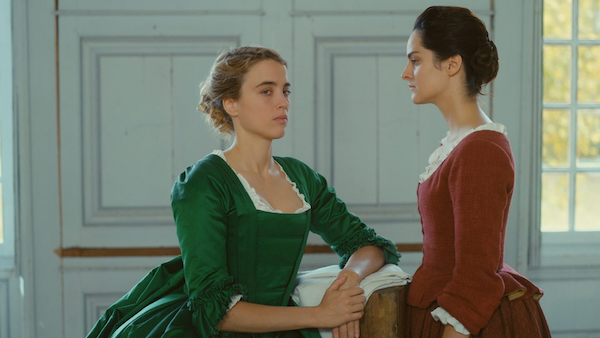Movie review by Greg Carlson
Outstanding writer-director Celine Sciamma adds another sublime cinematic work to her resume with “Portrait of a Lady on Fire.” A talent to watch since excellent debut feature “Water Lilies” (original title “Naissance des Pieuvres,” or “Birth of the Octopuses”) launched her career in 2007, Sciamma has developed into one of the most compelling storytellers in the movies over the course of just four features. Her other two, “Tomboy” and “Girlhood,” also attest to a sharp-eyed interest in coming-of-age tales, sexual identity, and considerations of societal constraints and expectations related to the performance of gender.
Sciamma’s first period piece may take place on an imposing island off the Brittany coast around 1770, but the central relationship of “Portrait” crackles and sparks with the same kind of electric charge found in the director’s present-day stories. Trained artist Marianne (Noemie Merlant) is commissioned by an affluent countess (Valeria Golino) to paint a likeness of the woman’s reluctant daughter Heloise (Adele Haenel) as part of a marriage proposal. Heloise, who refused to sit for a previous attempt, is deliberately misled into thinking that Marianne has been retained by the countess as a hired companion. Marianne works from memory to capture Heloise on canvas.
From first frame to last, “Portrait of a Lady on Fire” is alive with vibrant, confident filmmaking. Sciamma almost always favors the power of the purely visual over the use of dialogue to communicate intellectually and emotionally with her audience. There are many films about the passionate relationships that develop between artists and models, but Sciamma capably uses the process — initially complicated by Heloise’s absence before Marianne’s easel — to contemplate ideas large and archetypal as well as intimate and personal. Helene Delmaire, the artist whose hands double for Marianne, sketches and paints onscreen in real time, affording Sciamma an immediacy and authenticity free from the “cheats” of dissolves and cuts.
The gaze, the look, the construction and reconstruction of how we see what is really in front of us and how we reinterpret, reimagine, and idealize our desires through visual art — all of these components might very well fuel future essays on the many treasures of Sciamma’s movie. Equally fascinating are the ways in which the filmmaker connects women from the 18th century to women of today. “Portrait of a Lady on Fire” looks closely at female marginalization within the patriarchy through the texts and subtexts of abortion, forced marriage, and the monumental challenges faced by artists trying to carve out respect and opportunity in a space historically structured for men.
Throughout the film, Sciamma looks to the myth of Orpheus and Eurydice as a symbolic mirror for her characters, and a bonfire chanson is just one of the times the director charms living things and stones alike. Later, Sciamma locks down a blazing final act, setting up a gut-punch double ending that tops one unforgettable incident — a moment-in-time first contained and then transferred from one page 28 to another — with equal emotional devastation. Pulling off the unlikely feat of making a section of Vivaldi’s Concerto No. 2 in G minor, best known as the Four Seasons’ L’estate/Summer, seem new and fresh, Sciamma stitches the iconic music to her own poetry.
